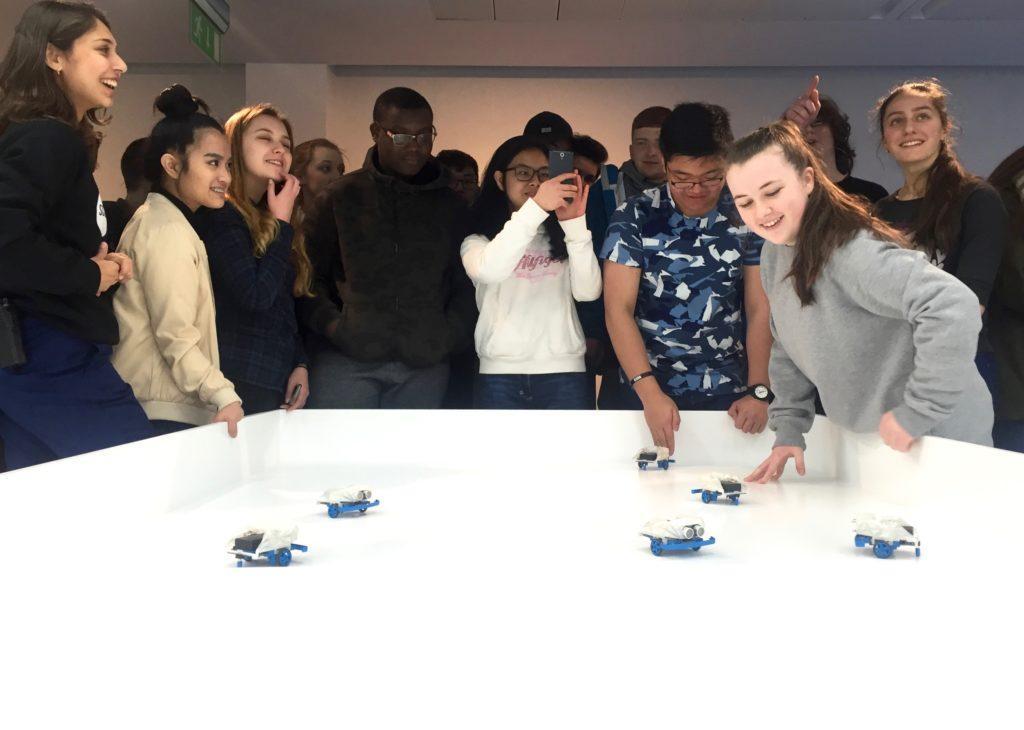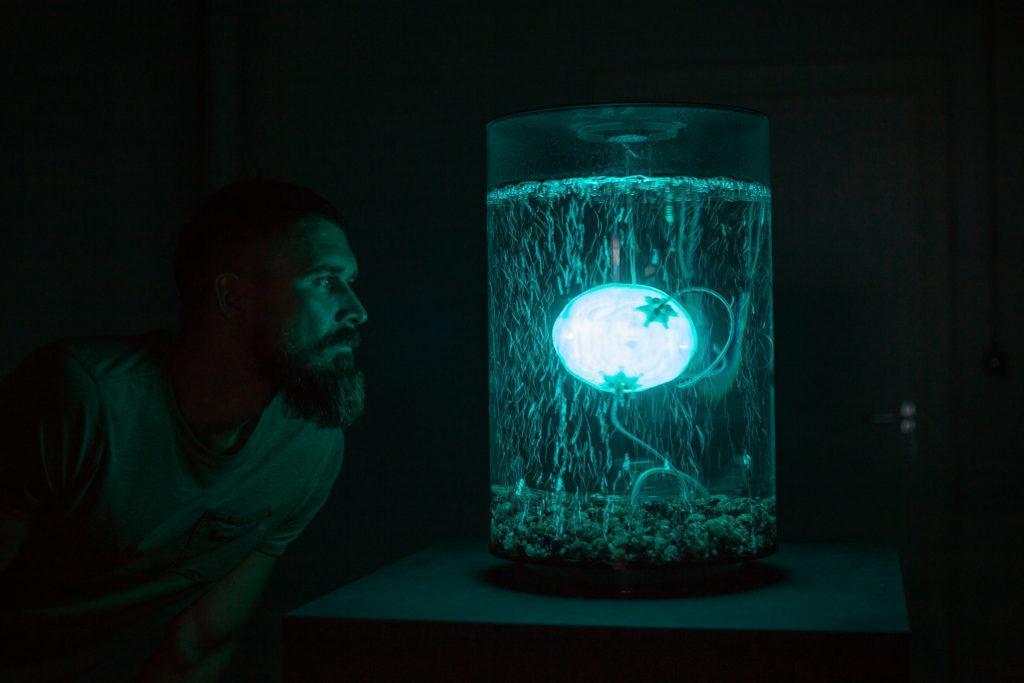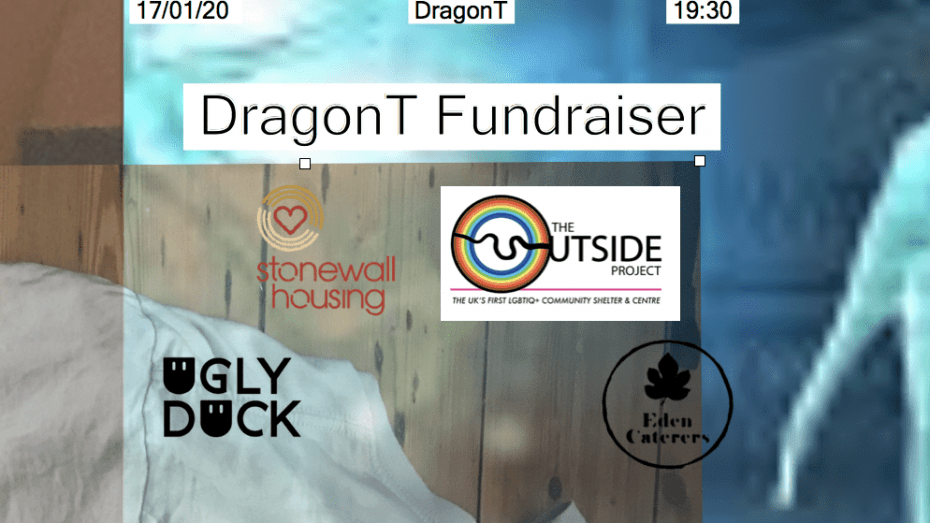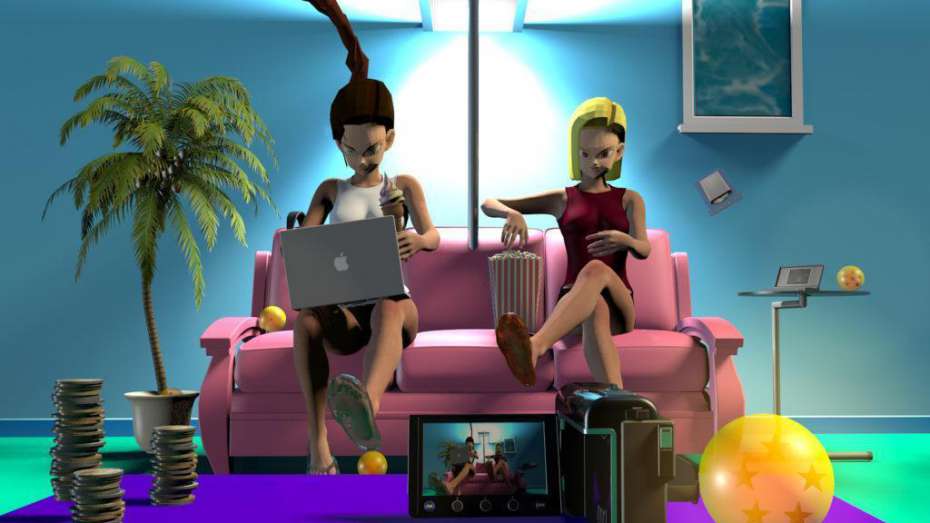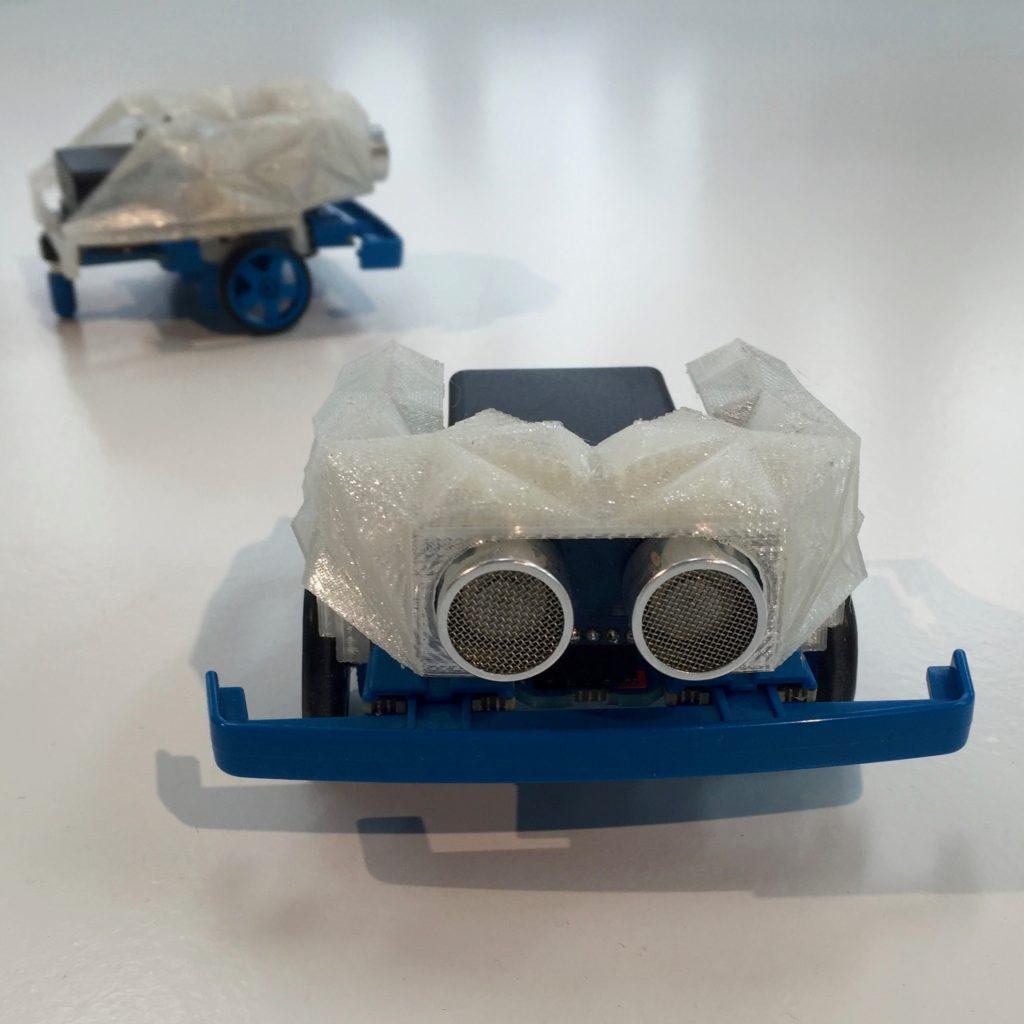
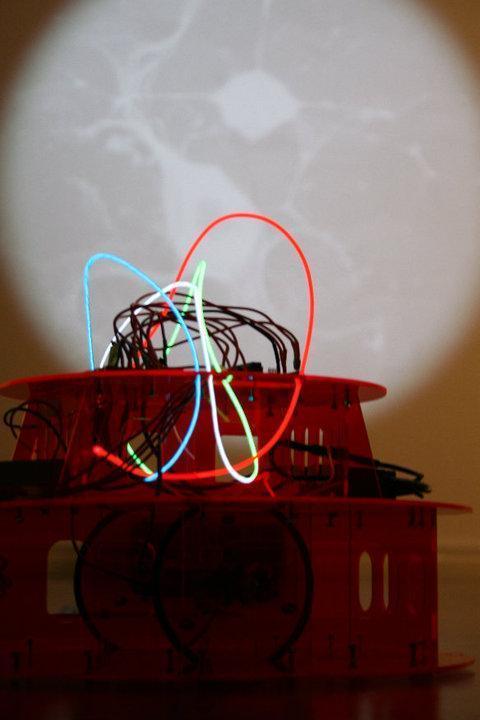
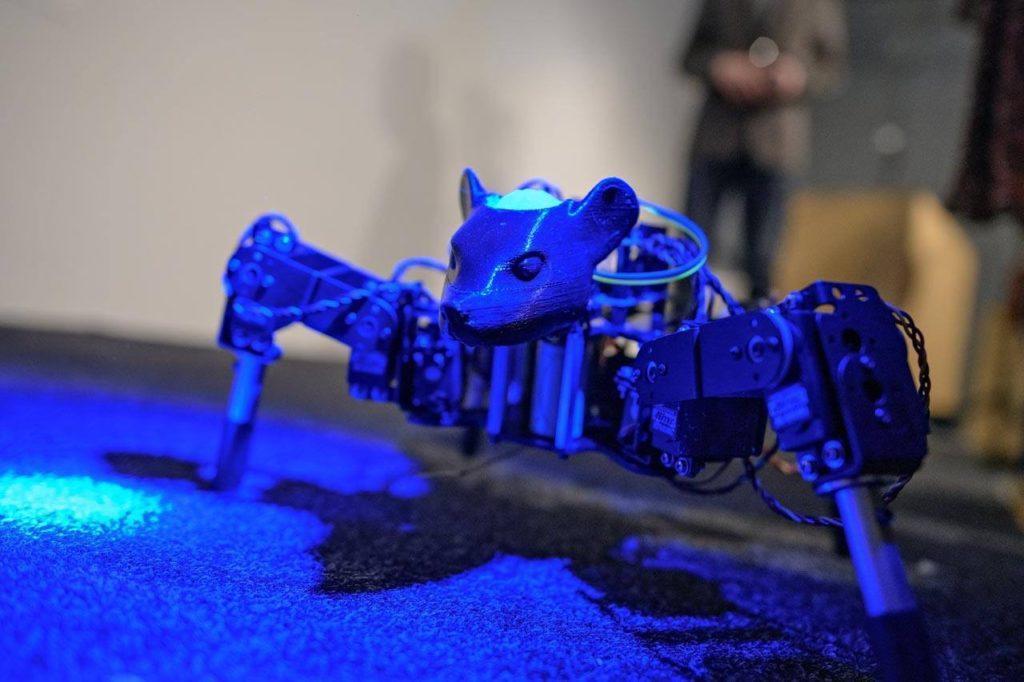
We caught up with Anna Dumitriu ahead of her exhibition Intelligent Machinery with Alex May
Hello Anna, thanks for taking some time out to talk to us about your practice.
The whole team at Ugly Duck are very fond of your work and we are really looking forward to hosting your exhibition from 27th to 29th September.
First can you tell us more about your practice, do you have a science or STEM background? How did you decide to use this to create an artistic output?
My work feels like a vocation, I have to do it, there was no decision on my part to follow this path, no choice. I explore areas of science that relate to the human condition and the nature of life, particularly in microbiology and infectious diseases or in how we relate to robots and AI. I work hands-on in the lab to make my work just as much as I work in my studio. I learnt how to do the work I do, which sometimes involves complex genetic modifications of bacteria, working with dangerous pathogens like tuberculosis or building robots using hardware and artificial intelligence, by working deeply embedded in science settings though in depth collaborations and artistic residencies for more than 20 years but not from what you would call a STEM background. I trained in fine art and for me art acts as a meta-discipline that allows me to explore not just science or technology but how they relate to cultural and societal history, psychology and behaviour, aesthetics and emotions. Art is not limiting and can allow me to tell complex stories in layered ways. The work has an immediate impact aesthetically and visually but as you peel away the layers of the work it reveals my research process and the concepts that informed the piece, it’s a kind of conceptual art. I’m fascinated in the history of science and medicine and their cultural contexts. My work aims to draw threads across time between early histories and future developments.
Can you tell us more about your collaboration with Alex May?
The show at Ugly Duck will be the first time our entire collaborative output in the area of robotic art has been on show in the same time and place. When I first met Alex May over 9 years ago I was artist in residence in the Centre for Computational Neuroscience and Robotics at the University of Sussex, one of the largest artificial life research groups in the world and was developing a human-robot performance work called “The Emergence of Consciousness” (which has recently been included in the Computer Arts Society Collection in fact). I was also developing a programme of art events for the Alan Turing Centenary as I was co-chair of the Arts and Culture Committee. We immediately hit it off and Alex’s expertise in programming and creating digital art meant we could combine our strengths and create works together that neither of us could create on our own.
When I was invited to be artist in residence in the School of Computer Science at the University of Hertfordshire I proposed that Alex and I both took on that role and we haven’t looked back. We tend to collaborate on robotics projects mainly but we work together whenever it’s appropriate and useful for each other, sometimes making joint works and sometimes solo works where we are listed as one of the collaborators. Most of our artistic outputs are in fact solo projects (often in collaboration with scientists) and we have no intention of combining our practice totally or working under a single ‘brand name’, we both think that would be weird, we want to keep our own individual identities.
Over the past year we worked with Amanda Wilson at Imperial College through an EMAP residency with LABoral in Spain to create “ArchaeaBot: A Post Singularity and Post Climate Change Life-form” and that will be on show at Ugly Duck and that has kept us very busy as it’s been (and continues to be) shown all around the world. Our collaboration with the University of Hertfordshire has been and continues to be fantastic for us and the show at Ugly Duck is in collaboration with them.
Alex and I both love to be busy and we tend to work very long hours. There’s an urgency, in terms of a desire to make work (rather than a concern for deadlines) that drives us both, so we have a perfect synergy.
Thinking about the intersection of Art, technology and science, how do you initiate a partnership with labs and scientists? What does this relationship bring to your practice and what benefits do you think they get from the collaboration?
I think I am now at a stage where I am quite well known for the work I do, at least in certain communities. People are aware of my passion and obsession with this stuff, and the more work I do, the more knowledge I assimilate and the more that triggers other ideas. That’s the thing with art, it’s exponential, the more you do, the more you need to do. So I’m lucky that now I am often invited by scientists to work with them. Such as with the National Collection of Type Cultures at Public Health England or Modernising Medical Microbiology at the University of Oxford, both incredible, ongoing relationships. In other cases when I am invited to work with a scientific team I need to show them I understand and value their work and ideas because there is a perception that an artist won’t be able to understand the science side, but I can usually get this past this quite quickly by showing them my past track record. I suppose the question is how did I get this track record that helps to open doors and that was really from pure tenacity, the hard work of learning how to do the science side and building upon layer after layer of learning. I didn’t get a specific lucky break and I do not come from any kind of privileged background. I am always keen to develop new collaborations and welcome approaches by scientists, researchers and technolgists.
Looking ahead to Intelligent Machinery programmed by you and Alex May, could you give us a glimpse of what to expect? Are you planning a majority showcase of your work or are you incorporating other artists who also work within arts and technology?
We are going to be exhibiting, for the first time in one place, all our robotics projects, many of which are collaborations with the researchers at the University of Hertfordshire as well as European collaborations. We’ll have our “ArchaeaBot: A Post Singularity and Post Climate Change Life-form” there with the premiere of a new sonic art work created by our scientific collaborator Amanda Wilson who is also an accomplished musician, sound artist and performer and currently transitioning to a full time career in this. We’ll have our humanoid robot “HARR1” a.k.a. “My Robot Companion”, our “Antisocial Swarm Robots”, our new “Biocomputation Robots” in collaboration with Professor Volker Steuber and Professor Freek Hoebeek, some other interactive or video-mapped works, maybe my “Emergence of Consciousness” robot from 2009-10, maybe our new (developing) robot that is attracted to smells – along with a bottle of perfume for humans that want to attract robots (which may be an increasing issue in the future). We are still putting the show together, it’s going to be fun and exciting. Lots of robotic artworks.
You are also organising a symposium as part of the programme, discussing topics surrounding the contemporary hype of AI and machine learning. What are your views on the current popularity of these subjects, do you think the hype within creative fields has had a positive or negative impact on the scientific research?
We get invited to lots of arts events about AI and often how it is presented seems very different to our experience in working embedded in the field, in my case for over 15 years in the AI and artificial life communities. At such events people either talk about deep learning as if it will solve literally everything or they paint a picture of future AI ‘winters’ – periods where the promise of AI has not lived up to expectations and it has gone out of fashion, and out of favour with funders. I think it is important to peel away at the surface of what is presented to the wider public by the media and find out what is really going on under the surface in research. There is so much more to AI and Artificial Life (AL) that seems to be discussed currently and that’s what we aim to do with our symposium. Deep learning needs to be combined with other areas of research such as biologically inspired computing, computer technology, computer security, battery design and even green computing to ensure it is really sustainable and will remain relevant.
I think the arts have a positive effect on public perception of AI because art can raise awareness and provide a forum for debate. However this doesn’t happen in every case. Several films recently have referenced Alan Turing and his ideas but they are often quite factually incorrect. One problematic science fiction film for me is Ex Machina which aside from being extremely sexist in objectifying the female form and having no female scientists or thinkers (aside from the robots themselves) totally mis-represents Turing’s work. People talk about things like the ‘Turing Test’ but have never read what Alan Turing actually wrote. It’s evolved to mean something quite different from Turing’s original paper where he asks what we would accept as passing for intelligence rather than what they would consider a genuine display of intelligence. In his paper “On Computing Machinery and Intelligence”(1950) Turing also discusses gender in this context and invents a ‘Victorian Parlour Game’ called the Imitation Game (that no-one has managed to ever find a reference to in Victorian books) where two hidden players have to decide if they are talking to a man or a woman based on notes passed between them. Turing discusses how a male player trying to ‘pass’ as a woman would have to give a stereotypical female responses rather than genuine female responses in order to convince another man that he was a female. In light of Turing’s own sexuality and subsequent death there is a lot more to this text than is usually recognised, and certain a lot more philosophical depth to Turing’s ideas than simply how to make an effective chatbot. This is true in all of Turing’s work and I’m always shocked by how under-recognised he is for his achievements. His unpublished 1948 paper “Intelligent Machinery” that our event is named after is to all intents and purposes the first manifesto of AI. Not only did Turing define the concept of the algorithm, that made general purpose computing possible, he also instigated the fields of artificial intelligence and artificial life. When I co-chaired the Arts and Culture Committee for the Turing Centenary he was very little known outside the computer science and mathematics worlds. Now thanks to our work and of course thanks to Hollywood he is known more widely but people still seem to know very little of his actual work which was the most important thing in his life by far. The thing is most of Turing’s work, including his major achievement in working with Tommy Flowers to build the first programmable, electronic digital computer Colossus at Bletchley Park, was covered under the official secrets act in the UK and for fifty years no-one could talk about it.
I hope the symposium can help to give people a deeper understanding of contemporary AI/AL and how we got to where we are now. I also want to consider best practice methods for the arts to engage in the field to raise awareness of ethical debates, communicate new research and even help in the innovation and/or implementation of that research.
Why do you think people, both creative and scientific practitioners, have started to take a more active role in exploring these subjects?
I think a lot of it is to do with a greater awareness of the impact of these technologies now which is of course related to media interest and of course commercial interests linked to start-up culture etc. With art you need curators and funders willing to support work and audiences willing to experience it and I think we are at that point with AI related art. I think we are much farther off than this level of momentum for areas I also work in such as one of synthetic biology and its mechanisms, I see very little of that work being done, at least beyond speculative art. I’ve read in the CRISPR Journal that I’m considered to be the first person to have made art hands on using the CRISPR DNA editing technique (in my “Make Do and Mend” project and I’ll be interested to see how that field evolves and whether it does so in similar ways to AI art.
You and Alex are both are extremely busy at the moment touring around the world for conferences and exhibitions, do you still find the time to create? Do you have any projects on the horizon that you can share with us?
We were recently fortunate to be awarded an EU STARTS residency together to explore human and robot co-mobility with Schindler in Switzerland and so that’s what we are focussed on together now, alongside many other solo projects. I’m working with the National Collection of Type Cultures to artistically explore the most historic collection of pathogenic bacteria in the world, exploring the huge issue of stigma of infectious diseases, also with Modernising Medical Microbiology with a focus on my ongoing fascination with tuberculosis, and developing a new project around Clostridium difficile bacteria with Jane Freeman at the University of Leeds. Alex is working on a new VR project exploring museum collections and digital preservation. Both Alex and I are also collaborating together on two other really exciting projects, one with the EU CHIC programme to explore biotechnology and new plant breeding methods around the crop chicory, and the other around yeast and synthetic biology with Professor Diethard Mattanovich at the BOKU in Vienna.
See more at www.annadumitriu.co.uk
Thank you so much for speaking with us, and we can’t wait to see some of your works and hear more about AI and Machine learning at the symposium.
